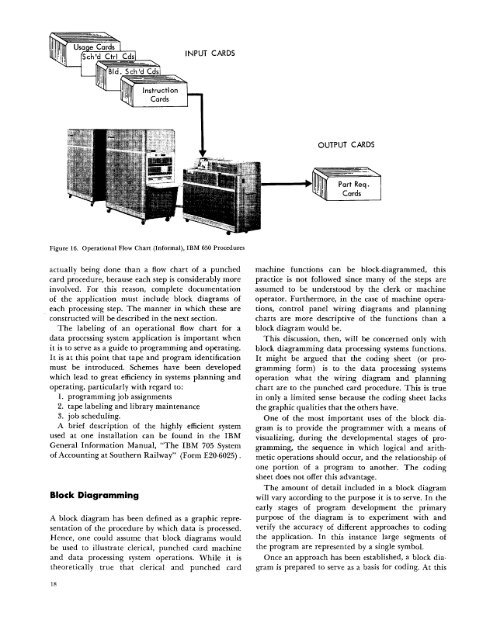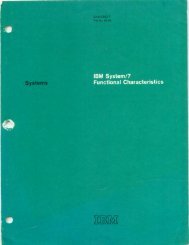Flow Charting and Block Diagramming Techniques - All about the ...
Flow Charting and Block Diagramming Techniques - All about the ...
Flow Charting and Block Diagramming Techniques - All about the ...
Create successful ePaper yourself
Turn your PDF publications into a flip-book with our unique Google optimized e-Paper software.
Figure 16. Operational <strong>Flow</strong> Chart (Informal), IBM 650 Proceduresactually being done than a flow chart of a punchedcard procedure, because each step is considerably moreinvolved. For this reason, complete documentationof <strong>the</strong> application must include block diagrams ofeach processing step. The manner in which <strong>the</strong>se areconstructed will be described in <strong>the</strong> next section.The labeling of an operational flow chart for adata processing system application is important whenit is to serve as a guide to programming <strong>and</strong> operating.It is at this point that tape <strong>and</strong> program identificationmust be introduced. Schemes have been developedwhich lead to great efficiency in systems planning <strong>and</strong>operating, particularly with regard to:I. programming job assignments2. tape labeling <strong>and</strong> library maintenance3. job scheduling.A brief description of <strong>the</strong> highly efficient systemused at one installation can be found in <strong>the</strong> IBMGeneral Information Manual, "The IBM 705 Systemof Accounting at Sou<strong>the</strong>rn Railway" (Form E20-6025) .<strong>Block</strong> <strong>Diagramming</strong>A block diagram has been defined as a graphic representationof <strong>the</strong> procedure by which data is processed.Hence, one could assume that block diagrams wouldbe used to illustrate clerical, punched card machine<strong>and</strong> data processing system operations. While it is<strong>the</strong>oretically true that clerical <strong>and</strong> punched cardmachine functions can be block-diagrammed, thispractice is not followed since many of <strong>the</strong> steps areassumed to be understood by <strong>the</strong> clerk or machineoperator. Fur<strong>the</strong>rmore, in <strong>the</strong> case of machine operations,control panel wiring diagrams <strong>and</strong> planningcharts are more descriptive of <strong>the</strong> functions than ablock diagram would be.This discussion, <strong>the</strong>n, will be concerned only withblock diagramming data processing systems functions.It might be argued that <strong>the</strong> coding sheet (or programmingform) is to <strong>the</strong> data processing systemsoperation what <strong>the</strong> wiring diagram <strong>and</strong> planningchart are to <strong>the</strong> punched card procedure. This is truein only a limited sense because <strong>the</strong> coding sheet lacks<strong>the</strong> graphic qualities that <strong>the</strong> o<strong>the</strong>rs have.One of <strong>the</strong> most important uses of <strong>the</strong> block diagramis to provide <strong>the</strong> programmer with a means ofvisualizing, during <strong>the</strong> developmental stages of programming,<strong>the</strong> sequence in which logical <strong>and</strong> arithmeticoperations should occur, <strong>and</strong> <strong>the</strong> relationship ofone portion of a program to ano<strong>the</strong>r. The codingsheet does not offer this advantage.The amount of detail included in a block diagramwill vary according to <strong>the</strong> purpose it is to serve. In <strong>the</strong>early stages of program development <strong>the</strong> primarypurpose of <strong>the</strong> diagram is to experiment with <strong>and</strong>verify <strong>the</strong> accuracy of different approaches to coding<strong>the</strong> application. In this instance large segments of<strong>the</strong> program are represented by a single symbol.Once an approach has been established, a block diagramis prepared to serve as a basis for coding. At this18
















